
The Legend of Zelda is an action-adventure game franchise created by the Japanese game designers Shigeru Miyamoto and Takashi Tezuka. It is primarily developed and published by Nintendo, although some portable installments and re-releases have been outsourced to Flagship, Vanpool, and Grezzo. The gameplay incorporates action-adventure and elements of action RPG games.
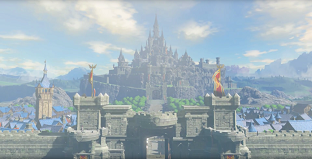
The Legend of Zelda is a video game franchise created by Japanese video game designers Shigeru Miyamoto and Takashi Tezuka. It is mainly developed and published by Nintendo. The universe of the Legend of Zelda series consists of a variety of lands, the most predominant being Hyrule. The franchise is set within a fantasy world that is reminiscent of medieval Europe and consists of several recurring locations, races and creatures. The most prominent population in the series are the Hylians, a humanoid race with elfin features, that are identifiable by their long, pointed ears. The game world is accompanied by a detailed fictional lore that contains a creation myth, several constructed languages, the most prominent being Hylian, and a fictional universal currency called the rupee. Most games in The Legend of Zelda series follow a similar storyline, which involves the protagonist Link battling monsters to save Princess Zelda and defeat an evil villain, which is often the series' main antagonist, Ganon. Nintendo developed the fictional lore into a complex timeline that spans across the series and chronicles thousands of years of fictional history.

The Legend of Zelda: Ocarina of Time is a 1998 action-adventure game developed and published by Nintendo for the Nintendo 64. It was released in Japan and North America in November 1998 and in PAL regions the following month. Ocarina of Time is the first game in The Legend of Zelda series with 3D graphics.

The Legend of Zelda: A Link to the Past is a 1991 action-adventure game developed and published by Nintendo for the Super Nintendo Entertainment System. It is the third game in The Legend of Zelda series and was released in 1991 in Japan and 1992 in North America and Europe.

The Legend of Zelda: Majora's Mask is a 2000 action-adventure game developed and published by Nintendo for the Nintendo 64. It was the second The Legend of Zelda game to use 3D graphics, following Ocarina of Time (1998). Designed by a creative team led by Eiji Aonuma, Yoshiaki Koizumi, and Shigeru Miyamoto, Majora's Mask was completed in less than two years. It featured enhanced graphics and several gameplay changes, but reused a number of elements and character models, which the game's creators called a creative decision made necessary by time constraints.

The Legend of Zelda: The Wind Waker is a 2002 action-adventure game developed and published by Nintendo for the GameCube. An installment in The Legend of Zelda series, it was released in Japan in December 2002, in North America in March 2003, and in Europe in May 2003.

The Legend of Zelda: Oracle of Seasons and The Legend of Zelda: Oracle of Ages are two 2001 action-adventure games in The Legend of Zelda series, developed by Flagship and published by Nintendo for the Game Boy Color.
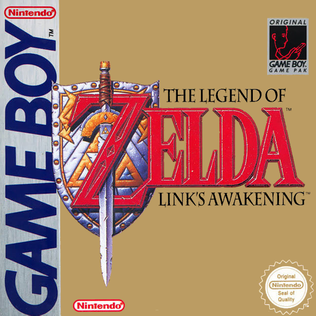
The Legend of Zelda: Link's Awakening is a 1993 action-adventure game developed and published by Nintendo for the Game Boy. It is the first installment in The Legend of Zelda series for a handheld game console. Link's Awakening is one of the few Zelda games not to take place in the land of Hyrule, and it does not feature Princess Zelda or the Triforce relic. Instead, the protagonist Link begins the game stranded on Koholint Island, a place guarded by a whale-like deity called the Wind Fish. Assuming the role of Link, the player fights monsters and solves puzzles while searching for eight musical instruments that will awaken the sleeping Wind Fish and allow him to escape from the island.

Princess Zelda is the titular character in Nintendo's The Legend of Zelda video game series. She was created by Shigeru Miyamoto for the original 1986 game The Legend of Zelda. As one of the central characters in the series, she has appeared in the majority of the games in various incarnations. Zelda is the elf-like Hylian princess of the kingdom of Hyrule, an associate of the series protagonist Link, and bearer of the Triforce of Wisdom.

Link is a fictional character and the protagonist of Nintendo's video game franchise The Legend of Zelda. He was created by Japanese video game designer Shigeru Miyamoto. Link was introduced as the hero of the original 1986 The Legend of Zelda video game and has appeared in a total of 20 entries in the series, as well as a number of spin-offs. Common elements in the series include Link travelling through Hyrule whilst exploring dungeons, battling creatures and solving puzzles until he eventually defeats the series' primary antagonist, Ganon, and saves Princess Zelda.

Ganon is a character and the primary antagonist of Nintendo's The Legend of Zelda video game series and franchise, as well as the final boss in many Zelda titles. In his humanoid Gerudo form, he is known as Ganondorf. A massive and malevolent pig creature, Ganon first appeared in the original The Legend of Zelda game in 1986, while his alter ego, Ganondorf, was introduced in Ocarina of Time. He has since appeared in the majority of the games in the series in various forms. He is the archenemy of the protagonist Link and Princess Zelda of Hyrule and originally the leader of the Gerudo, a race of humanoid desert nomads before becoming the ruler of his demon army.
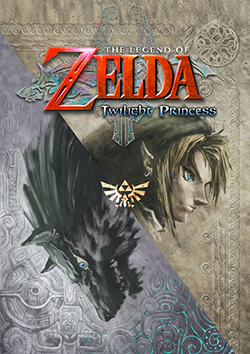
The Legend of Zelda: Twilight Princess is a 2006 action-adventure video game developed and published by Nintendo for the GameCube and Wii. Originally planned for release exclusively on the GameCube in November 2005, Twilight Princess was delayed by Nintendo to allow its developers to refine the game, add more content, and port it to the Wii. The Wii version was a launch game in North America in November 2006, and in Japan, Europe, and Australia the following month. The GameCube version was also released in December 2006 as the final first-party game for the console.

The Super Mario Bros. Super Show! is an American live-action/animated television series that aired from September 4 to December 1, 1989, in syndication. The series is based on the video games Super Mario Bros. and Super Mario Bros. 2 by Nintendo, and is the first of three television series to be based upon the Mario video game series. The animation was provided by Sei Young Animation.

Midna is a fictional character in Nintendo's The Legend of Zelda series, introduced as one of the main protagonists in Twilight Princess. She is a member of the magic-wielding Twili who joins forces with Link to prevent the kingdom of Hyrule from being enveloped by a corrupted parallel dimension known as the Twilight Realm. While Midna appears as an imp-like creature in the majority of Twilight Princess, her actual form is humanoid. She was designed by Yusuke Nakano and voiced by Akiko Kōmoto. Midna's first appearance was in a trailer for Twilight Princess shown at the 2005 Electronic Entertainment Expo (E3); at the time, her gender was unknown, leaving some journalists confused about it.
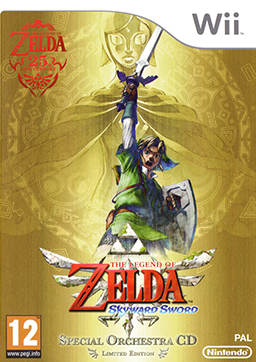
The Legend of Zelda: Skyward Sword is a 2011 action-adventure game developed and published by Nintendo for the Wii. A high-definition remaster of the game, The Legend of Zelda: Skyward Sword HD, was co-developed by Tantalus Media and released for the Nintendo Switch in July 2021.

Navi is a fictional fairy who acts as series protagonist Link's navigator throughout the 1998 Nintendo 64 video game The Legend of Zelda: Ocarina of Time. She was voiced by Kaori Mizuhashi. Navi performs a variety of functions within the game, including being a companion and guide to Link, providing the player with advice and being a focal point for the game's Z-lock targeting combat system. She has been widely criticised by players and critics for her repetitive interruptions in gameplay, particularly with the prompt "Hey! Listen!".
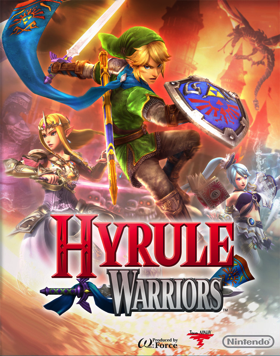
Hyrule Warriors is a hack and slash video game developed by Omega Force and Team Ninja for the Wii U video game console. The game is a collaboration between Koei Tecmo and Nintendo, mixing settings and characters from Nintendo's The Legend of Zelda with the gameplay of Koei's Dynasty Warriors series. Hyrule Warriors was released in Japan in August 2014, and worldwide the following month. It became one of the best-selling games on the Wii U. An updated port, Hyrule Warriors Legends, was released for the Nintendo 3DS in Japan in January 2016 and worldwide in March of the same year. A second enhanced port, Hyrule Warriors: Definitive Edition, was released for the Nintendo Switch in 2018. A successor, Hyrule Warriors: Age of Calamity, was released exclusively for the Nintendo Switch in November 2020.

The Legend of Zelda is a high-fantasy video game series created by Japanese game designers Shigeru Miyamoto and Takashi Tezuka. It is primarily developed and published by Nintendo, although some portable installments have been outsourced to Capcom, Vanpool and Grezzo. The series' gameplay incorporates elements of action, adventure, and puzzle-solving games.
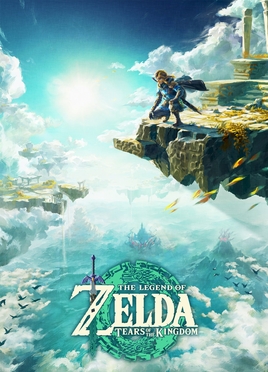
The Legend of Zelda: Tears of the Kingdom is a 2023 action-adventure game developed and published by Nintendo for the Nintendo Switch. The sequel to The Legend of Zelda: Breath of the Wild (2017), Tears of the Kingdom retains aspects including the open world of Hyrule, which has been expanded to allow for more vertical exploration. The player controls Link as he searches for Princess Zelda and fights to prevent the Demon King from destroying the world.

















